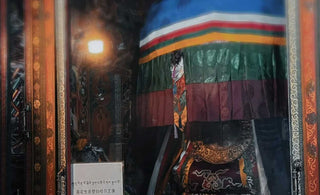
Exploring the Depth of Tradition and Mastery
Tibetan Buddhist art stands as an embodiment of centuries-old traditions and impeccable craftsmanship. The fusion of spirituality, history, and artistic finesse within these creations elevates them to a level of profound significance. Within the realm of Oriental heritage, these artistic treasures find their sanctum, revered for their cultural value and aesthetic brilliance.
Understanding the Essence: Heritage Woven in Colors
Tibetan Buddhist art stands as a testament to a cultural legacy woven into the vibrant tapestry of colors, intricacies, and symbolism. It's a visual chronicle that encapsulates the essence of Tibetan heritage, spirituality, and artistic expression. At its core, this art form serves not only as a visual delight but also as a means to communicate the teachings and philosophies embedded in Tibetan Buddhism.
Each stroke of the brush, every hue meticulously chosen, tells a story deeply rooted in the traditions that have evolved over centuries. The art reflects the cultural amalgamation of Tibetan Buddhism, Hinduism, and indigenous Tibetan Bon religion, blending to form a unique artistic expression.
The Meticulous Craft: Artistry in Every Detail
The craftsmanship behind Tibetan Buddhist art is awe-inspiring. Master artisans devote years to mastering various techniques, from thangka painting to sculpting. Thangkas, traditional Tibetan scroll paintings, stand out as quintessential examples of this profound art form. These meticulously crafted scrolls depict intricate scenes from Buddhist cosmology, showcasing deities, mandalas, and symbolic representations of philosophical concepts. The creation of a Thangka involves a complex process that demands unwavering patience, meticulous attention to detail, and adherence to ancient techniques passed down through generations.
The artists, known as Thangka painters, adhere to strict guidelines laid out in ancient texts that define the proportions, colors, and iconography, ensuring the authenticity and sacredness of these works. The vibrant colors used in Thangkas - derived from natural minerals, stones, and plants - not only offer aesthetic beauty but also hold deep symbolic significance.
Beyond Thangkas, Tibetan Buddhist sculptures also stand as exemplars of this extraordinary craftsmanship. Sculptors carve intricate figures of Buddhas, bodhisattvas, and deities, employing a diverse range of materials such as wood, metal, and stone. These statues are not merely objects of worship; they serve as aids for meditation, inspiring devotees on their spiritual journey.
The artistic pursuit behind Tibetan Buddhist art extends beyond mere craftsmanship; it's a spiritual practice, an act of devotion, and a gateway to enlightenment. The artists themselves often engage in meditative practices before and during the creation of these masterpieces, infusing their work with spiritual energy and intention.
Symbolism and Spiritual Depth: Beyond Aesthetics
Every symbol and color in Tibetan Buddhist art holds profound meaning. Mandalas, perhaps the most iconic representation in Tibetan Buddhist art, encapsulate the universe within their intricate designs. These sacred circles symbolize the cosmos, portraying a visual journey from the outer world to the inner sanctum of enlightenment. Mandalas serve as visual aids for meditation, guiding practitioners towards spiritual awakening and self-realization.
The intricate patterns and geometrical shapes within mandalas represent the complexities of existence. They symbolize unity, harmony, and the interconnectedness of all beings. As one gazes upon a mandala, they are invited to contemplate the interconnected nature of life, fostering a sense of tranquility and oneness with the universe.
Colors within Tibetan Buddhist art hold deep symbolic meaning. Blue signifies wisdom and clarity, representing the sky and the vastness of knowledge. It reminds practitioners to seek understanding and enlightenment. Green symbolizes balance, harmony, and the flourishing of life. Red embodies passion, energy, and the transformative power of emotions.
The symbolism extends beyond colors to encompass various spiritual symbols. The Eight Auspicious Symbols, known as Tashi Targye, adorn many artworks, each carrying a unique representation of blessings and virtues. The Dharma wheel signifies the teachings of Buddha, while the conch shell represents the beautiful sound of the Buddha's teachings, echoing across the universe.
Tibetan Buddhist art isn't confined to galleries or monasteries; it's a transformative medium for personal growth and spiritual connection. Engaging with these artworks isn't merely about visual pleasure but a profound experience that touches the soul.
Admirers and practitioners often find themselves drawn to specific pieces, experiencing an emotional and spiritual resonance that transcends words. The contemplation of these artworks leads to introspection, inner peace, and a deeper understanding of oneself and the universe.
Preservation and Appreciation: Nurturing an Ancient Heritage
Oriental Aesthetics stands as a beacon for all aficionados of classical Oriental art. We provide a platform for artists to showcase their talent and connect with collectors and enthusiasts worldwide. Our services cater to the preservation, promotion, and appreciation of Oriental art, fostering a community passionate about the rich cultural heritage embodied in these artworks.























